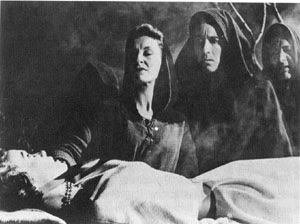 The Scoop:
The Scoop:Think "Grumpy Old Men" meets "I Know What You Did Last Summer" (but with a little more class than either of those) and you'll get the idea of what's up with "Ghost Story."
Four elderly men in a small Vermont town call themselves the "Chowder Society" and have been sharing brandy, cigars and ghost stories since their youth. However, they also share an old secret, and when a circle of mysterious deaths starts closing in on them, it finally becomes time to confront their past.
What is basically a lukewarm cliché-ridden thriller (based on the novel by Peter Straub) is made watchable by the four old pros -- Fred Astaire, Melvyn Douglas, Douglas Fairbanks Jr. and John Houseman -- who give what amounts to swan-song performances, as well as by Alice Krige's turn as The Creepy Girl. There are also a few scares and chills -- just enough to keep you watching until the end. This may not be the best ghost story in the world, but you could certainly do worse.
Best Line:
Just about anything Krige says, since it's not so much what she says as how she says it. (Although "Dance with me, you little toad!" is hard to beat.) You can definitely see the seeds of her Star Trek Borg Queen portrayal here.
Side Note:
Phillipe Sarde's score has since become standard library music for many soap operas and telenovelas.
Companion Viewing:
"I Know What You Did Last Summer" (1998) and "What Lies Beneath" (2000).
Links:
IMDb.
Take a Look:
You're mostly out of luck, folks. The only clip to be found online is a downloadable full version of the film on AOL Video, but it's a pay service, and only available to Windows XP and 2000 users. But give it a try here if you're so inclined.








